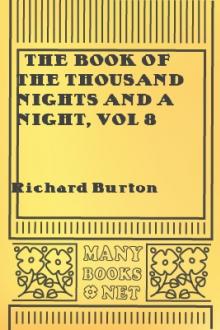The Book of the Thousand Nights and a Night, vol 6 by Sir Richard Francis Burton (best ereader for pdf and epub .TXT) 📕

The Book Of The THOUSAND NIGHTS AND A NIGHT Sindbad The Seaman[FN#1] and Sindbad The Landsman.
There lived in the city of Baghdad, during the reign of the Commander of the Faithful, Harun al-Rashid, a man named Sindbád the Hammál,[FN#2] one in poor case who bore burdens on his head for hire. It happened to him one day of great heat that whilst he was carrying a heavy load, he became exceeding wea
Read free book «The Book of the Thousand Nights and a Night, vol 6 by Sir Richard Francis Burton (best ereader for pdf and epub .TXT) 📕» - read online or download for free at americanlibrarybooks.com
- Author: Sir Richard Francis Burton
- Performer: -
Read book online «The Book of the Thousand Nights and a Night, vol 6 by Sir Richard Francis Burton (best ereader for pdf and epub .TXT) 📕». Author - Sir Richard Francis Burton
[FN#345] “Ante Kam� tak�l”=the vulgarest Cairene.
[FN#346] This may be Ctesiphon, the ancient capital of the Chosro�s, on the Tigris below Baghdad; and spoken of elsewhere in The Nights; especially as, in Night dclxvii., it is called Isbanir Al-Mad�in; Mad�in Kisr� (the cities of Chosro�s) being the Arabic name of the old dual city.
[FN#347] Koran vi. 103. The translation is Sale’s which I have generally preferred, despite many imperfections: Lane renders this sentence, “The eyes see not Him, but He seeth the eyes ;”
and Mr. Rodwell, “No vision taketh in Him ( ?), but He taketh in all vision ,” and (better) “No eyesight reacheth to Him.”
[FN#348] Sale (sect. 1.) tells us all that was then known of these three which with Y�’�k and Nasr and the three “daughters of God,” Goddesses or Energies (the Hindu Saktis) All�t Al-Uzz� and Man�t mentioned in the Koran were the chiefs of the pre-lslamitic Pantheon. I cannot but suspect that all will be connected with old Babylonian worship. Al-Bayd�wi (in Kor. Ixxi. 22) says of Wadd, Suw�‘a, Yaghus, Ya’�k and Nasr that they were names of pious men between Adam and Noah, afterwards deified: Yagh�s was the giant idol of the Mazhaj tribe at Akamah of Al-Yaman and afterwards at Najr�n Al-Uzz� was widely worshipped: her idol (of the tree Semurat) belonging to Ghataf�n was destroyed after the Prophet’s order by Kh�lid bin Wal�d. All�t or Al-L�t is written by Pocock (spec. 110) “Ilahat” i.e. deities in general. But Herodotus evidently refers to one god when he makes the Arabs worship Dionysus as {Greek letters} and Urania as {Greek letters}
and the “tashdid” in All�t would, to a Greek ear, introduce another syllable (Alilat). This was the goddess of the Kuraysh and Thak�f whose temple at Ta�f was circuited like the Ka’abah before Mohammed destroyed it.
[FN#349] Shays (Shayth) is Ab Seth (Father Seth,) of the Hebrews, a name containing the initial and terminal letters of the Egypto-Phoenico-Hebrew Alphabet and the “Abjad” of the Arabs. Those curious about its connection with the name of Allah (El), the Zodiacal signs and with the constellations, visions but not wholly uninteresting, will consult “Unexplored Syria” (vol. i.
33).
[FN#350] The exclamation of an honest Fellah.
[FN#351] This is Antar with the Chosro� who “kissed the Absian hero between the eyes and bade him adieu, giving him as a last token a rich robe.” The coarser hand of the story-teller exaggerates everything till he makes it ridiculous.
[FN#352] The context suggests thee this is a royal form of “throwing the handkerchief;” but it does not occur elsewhere. In face, the European idea seems to have arisen from the oriental practice of sending presents in napkins or kerchiefs.
[FN#353] i.e. if the disappointed suitor attack me.
[FN#354] i.e. if ever I he tempted to deny it.
[FN#355] Arab. “Mus�fahah,�’ the Arab fashion of shaking hands.
The right palms are applied flat to each other; then the fingers are squeezed and the hand is raised to the forehead (Pilgrimage ii. 332).
[FN#356] A city and province of Khuzist�n the old Susiana. Dasht may be either the town in Khorasan or the “forests” (dasht) belonging to Ahw�z (Ahuaz in D’Herbelot).
[FN#357] This is the contest between “Antar and the Satrap Khosrewan at the Court of Monzer.” but without its tragical finish.
[FN#358] Elliptical “he rode out in great state, that is to say if greatness can truly be attributed to man,” for, etc.
[FN#359] According to D’Herbelot (s.v. Rostac) it is a name given to the villages of Khorasan as “Souad” (Saw�d) to those of Irak and Makhlaf to those of Al-Yaman: there is, how ever, a well-known Al-Rustak (which like Al-Bahrayn always takes the article) in the Province of Oman West of Maskat, and as it rhymes with “Irak” it does well enough. Mr. Badger calls this ancient capital of the Ya’arubah Imams “er-Rast�k” (Imams of Oman).
[FN#360] i.e. a furious knight.
[FN#361] In the Mac. Edit. “Hass�n,” which may rhyme with Nabh�n, but it is a mere blunder.
[FN#362] In Classical Arabic Irak (like Yaman, Bahrayn and Rust�k) always takes the article.
[FN#363] The story-teller goes back from Kufah founded in Omar’s day to the times of Abraham.
[FN#364] This man�uvre has often been practiced; especially by the first Crusaders under Bohemond (Gibbon) and in late years by the Arab slavers in Eastern Intertropical Africa. After their skirmishes with the natives they quartered and “bristled” the dead like game, roasted and boiled the choice pieces and pretended to eat the flesh. The enemy, who was not afraid of death, was struck with terror by the idea of being devoured, and this seems instinctive to the undeveloped mind.
End of Project Gutenberg’s The Book of the Thousand Nights and a Night, V6





Comments (0)